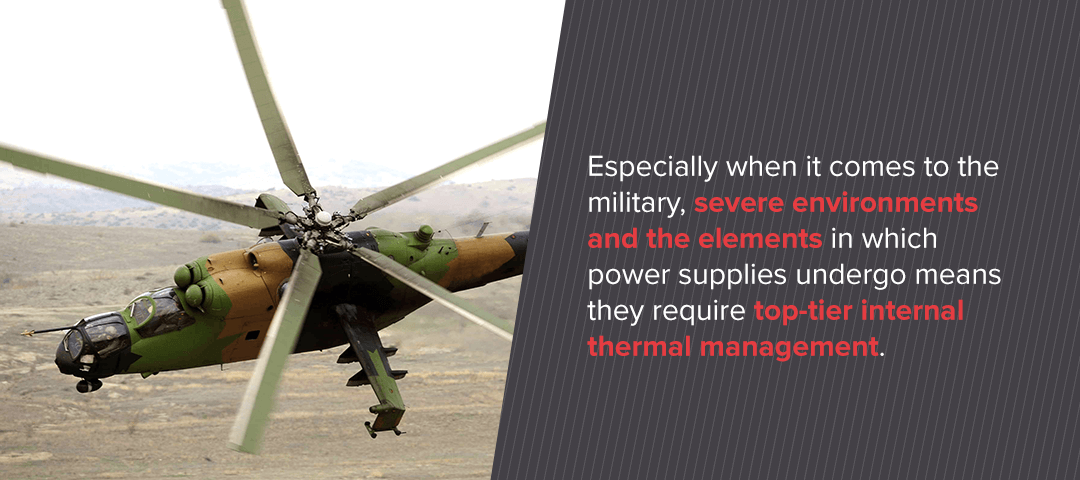
Both military defensive and offensive strategies rely on power supply devices to deliver power to technology during critical operations and in harsh environments. Looking ahead to 2022 and the years to come, five major power supply trends are on the horizon as the market continues to expand.
The overall power supply market is projected to reach about 42,500 million by 2027 with a compound annual growth rate (CAGR) of 4.73% from 2020 to 2027, according to Verified Market Research. There will be a growth in military and aerospace power supply requirements, along with other industries like home and building, electronics, and health care.
Advanced Conversion Technology delivers strong engineering capabilities to support full product life cycles. The majority of our power supply solutions are designed and built to customer performance specifications. Whether you demand power for communication devices or power systems on aircraft, ships, and vehicles, we can provide the help you need.
Quick Navigation:
- Military Power Supply Market
- 5 Military Power Supply Trends
- Thermal Management
- Standardization
- System Integration
- SWaP-C Limitations
- Increased Supply Chain Pressures
A Look into the Military Power Supply Market
A power supply, either an alternating current (AC) or direct current (DC), is an electrical device that delivers power to one or more electric loads. It usually converts one form of electrical power to another form. For example, AC into DC. It can also be known to convert different forms of energy such as chemical, mechanical, and solar into electrical power. Advanced Conversion Technology has been designing and building power supplies relied upon by our armed forces around the globe for over 40 years.
The rise in the military power supply market is a result of an increase in telecommunications and the surge in demand for energy-efficient devices. However, a few restraints exist within the market, such as an increase in renewable energy and high-voltage direct current (HVDC) sources and safety standards.
Unlike other industries, the military-grade power supply market has strict operational demands. These standards require each power supply to be durable, reliable, and rugged to withstand various and often extreme applications. The devices need to endure long cycles of use, have minimal maintenance, and work in harsh climates and terrains.
The military defensive and offensive sectors heavily rely on electrically powered systems. Standard military power supplies are usually either AC-DC or DC-DC. AC-DC power supplies can be either three or single-phase with a frequency of either 60Hz or 400Hz. With a strict set of standards needed for each type of power supply, high power density power conversion units that are efficient and dependable are critical to support various military loads.
5 Military Power Supply Trends for 2022
As the military power supply industry continues to grow, we’ll see various trends arising, including:
- Thermal management
- Standardization vs. customization
- Integration
- SWaP-C and power efficiency
- Increased supply chain pressures
1. Thermal Management
Thermal management will remain a key part of power design within the global industrial power supply market. All power supply units must survive high temperatures while remaining cool, but as devices get smaller and faster with higher power levels, it becomes more challenging to keep power supply units cool.
This is why thermal management is a major trend now and will continue to be one in the future. Managing temperatures keeps the units cool and creates a more efficient output of power. Especially when it comes to the military, severe environments and the elements in which power supplies undergo means they require top-tier internal thermal management. Military power supplies must withstand harsh applications where unit temperatures are critical.

2. Standardization
The move to power supply standards vs. custom power supplies is a massive trend in 2022. With a push toward standardization, you can gain access to ready-to-use power supply units that already meet industry standards. Engineered solutions are necessary to create precise units for specific applications, and when you merge a standardized power supply with an application-specific system, new capabilities arise.
In previous years, the power supply industry upheld some level of standardization with Versa Module Eurocard (VME) and Compact Peripheral Component Interface (CompactPCI, cPCI). But in 2022, we are expecting open-architecture standards like Virtual Path Cross-Connect (VPX) by VMEbus International Trade Association (VITA) to replace VME and cPCI.
Before, VME didn’t truly have any standards because it was unique to each system and dependent on size. Now with VPX, size, configurations and other subcategories are standardized. With these updated standardization requirements in place for 2022, market and deployment times will decrease because the power supplies have already undergone testing like shock and vibration, EMI, and environmental. Another one to be aware of is the Sensor Open Systems Architecture (SOSA) standard.
As standardization evolves into the new norm, the power supply industry can create new standard designs to meet military demands.
3. System Integration
System integration will increase in 2022 as power units begin to combine with microprocessors, high-speed networks, and innovative thermal management. The military and other industries expect more from power supply units moving forward. Instead of the unit itself, there is a trend toward integration which involves smart systems and networking capabilities.
With more integration comes more features in one power device as opposed to partnering with different companies at once. In 2022, we will see power supply companies for military applications and other sectors become a one-stop shop for power and networking systems.
System integration even leads to complete power supply unit solutions and an avenue for artificial intelligence, digital signal and graphics processors.
4. SWaP-C Limitations
SWaP-C (size, weight, power and cost) will remain a priority within the military power supply sector. Like any industry, the military is always looking at size, weight, power, and cost reductions while remaining precise and efficient. Because these four factors are an integral part of the design process, they also affect form, price, temperature, and operational standards of a high-voltage system.
SWaP-C requirements depend on what the military system demands from the power supply. For example, a power supply unit for a vehicle will be different in size and weight compared to that of an aircraft. SWaP-C also has a lot to do with material usage like looking to use switching technologies based on gallium nitride (GaN) and silicon carbide (SiC) instead of the traditional silicon (Si). GaN and SiC are faster and smaller in size to help improve SWaP-C
As technology progresses, higher voltage power supplies need to be just as efficient in distribution while protecting the supply’s internal components. Managing higher levels of power efficiently also requires additional circuit protection. As a result, the size and weight of a power unit can decrease as power efficiency increases.
The ever-pressing goal is to get the most amount of power in the smallest power supply unit that has an excellent cooling system.
5. Increased Supply Chain Pressures
Defense manufacturers like Advanced Conversion Technology are working hard to minimize the current supply chain challenges. A sharp increase in demand due to events in Ukraine and around the world has been coupled with a scarcity of resources that happened in the last 2 years of shutdowns due to the ongoing COVID-19 pandemic.
The trend to standardize is helping with supply chain pressures as it’s possible to look for stocked items or items that are close to completion in the production cycle. Another way to minimize supply chain issues is to look for products close to what is needed and evaluate alternatives that are proven. By working with your vendors, you can define your project around readily available items to create a military-modified off-the-shelf (MOTS) unit instead of doing a full custom product that may require months of lead-time due to supply chain issues.
A word of caution when looking for products in high demand or hard to get is counterfeit products. If the product doesn’t have a valid certificate of conformance (CoC) from the original equipment manufacturer (OEM), steer clear of it even if you’re in dire need of the product. Your product failing due to counterfeit material is not desirable despite the supply chain pressure of getting the part now.
Advance Your Power Supply Needs
Advanced Conversion Technology offers flexible and high-performance power supply solutions that are reliable and affordable for the military and other industries. By looking at the power supply trends of 2022, we are able to grow with upcoming technological advances to help you remain a competitive force.
Contact our team for additional information or view our AC-DC, DC-DC, COTS, and MOTS power supplies to see what we have to offer. If you don’t see a solution that works for your military application, we can design and manufacture engineered solutions for your needs.
